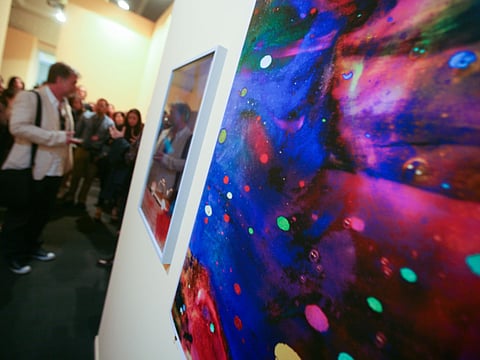In defence of Abraaj, a champion of art
The regional art industry is left poorer by the departure of an institution that collected works and commissioned new ones

Over the past few months, a steady drip of devastating news emanated from Abraaj Capital, the once venerated regional financial giant that is now in liquidation. Almost immediately WhatsApp messages and memes were shooting across the Middle East poking fun at the firm. This reminded me of the Arabic proverb, “As the camel falls to its knees, knives multiply.”
While much has been said about the systemic failures in both corporate governance at the firm as well as regulatory oversight, there is the one not insignificant aspect of the Abraaj story that has been overlooked, that of its role in supporting the regional art industry. For better or worse, the fact is that for the past dozen years Abraaj has played an important role in funding and championing regional art. This came in the form of collecting works and commissioning new ones, making them available for loans and the publishing books detailing these works with scholarly input.
Abraaj was amongst the only art institutions in the region to have developed an art collection that in total is estimated to number in the hundreds of works. This past week over a series of auctions in London this collection was broken up and sold in pieces to the highest bidder. For the UAE especially this is a double loss: the loss resulting from the collapse of a major financial institution is compounded by the fact that these hundreds of important artworks once domiciled in the UAE are now being dispersed throughout the world, the third such collection to leave UAE in the past few years.
Despite being a major financial hub, except Abraaj, UAE financial institutions have not invested in building significant art collections unlike their regional counterparts such as Morocco’s Attijariwafa Bank and Lebanon’s Bank Audi. Abraaj’s collection could have formed the nucleus of a UAE art museum. But this is no longer possible.
Essentially there are three sides to the “Abraaj art collection” the largest of which is the art collection that was built through acquisitions in art auctions and private sales that belonged to the bank. The second set of works belong to the firm’s founder Arif Naqvi and are categorised as a personal collection. The final set of works were commissioned artworks that entered the collection through the Abraaj Capital Art Prize. However, what set the Abraaj collection apart was its regional focus. The works in the collection came from artists in what is referred to as the Menasa region or the Middle East, North Africa and South Asia. Sadly this is the very region of the world that is in most need of investment in the arts and culture.
Further to Abraaj’s art collection is the role it played in supporting other institutions. At the very outset of the founding of Art Dubai in 2007, back when it was named Gulf Art Fair, Abraaj was at the forefront of backers, providing lead financial support for the event that now attracts over 28,000 visitors a year. While sponsors came and went since the fair’s founding, Abraaj stuck around through thick and thin. In 2008 the Abraaj Capital Art Prize was established to complement Art Dubai as the largest regional art prize by far. The Prize awarded the first artists $200,000 (Dh734,000) to create works that would go into the Abraaj collection.
By 2018 the collection included nearly 30 works that went on to be loaned to 68 institutions such as the Solomon R Guggenheim Museum in New York, the Victoria and Albert Museum in London and the MAXXI in Rome. The well-respected art historian and specialist in South Asian art, Savita Apte, as chair of the prize, oversaw these commissions thereby ensuring a certain standard of quality. Many of the artists who have received the award have gone on to have solo shows at major museums in Europe, the US and the Middle East.
Invaluable lessons
Through the award, artists were able to realise their artistic creativity away from the constraints set by financial considerations, their commercial gallery or individual collectors. Other forms of patronage came in Abraaj’s support for art education. In 2014 it established the Abraaj Royal College of Art Innovation Scholarship which covered full tuition fees to study at a Master’s level for two years at the RCA to five students annually. The 20 recipients hailed from countries as diverse as Ghana, India, Mexico, Kazakhstan and the UAE. That too is no more.
It would be naive to think that this art patronage was completely altruistic. Indeed Abraaj had a lot to gain from funding Art Dubai for over a dozen years. There is naturally an element of prestige, the goodwill that is generated amongst collectors in the region, many of whom were also Abraaj clients is unquantifiable. The works that were acquired and or commissioned also had an inherent financial value that was evident from the recent auction sales.
The tale of Abraaj’s collapse offers invaluable lessons not only to other institutions but also to art collectors such as whether plans need to be laid out for collections in the event of a crisis. There is no doubt that Abraaj’s financial managers messed up, their compounded mistakes continue to be documented by the media. However, when one looks back at its legacy, it is important to consider more than one facet of its story. Ultimately, the regional art industry is left poorer as a result of the departure of such an important actor. So for those who celebrated the collapse of Abraaj Capital, think again.
Sultan Sooud Al Qassemi is a UAE-based writer.
Sign up for the Daily Briefing
Get the latest news and updates straight to your inbox



